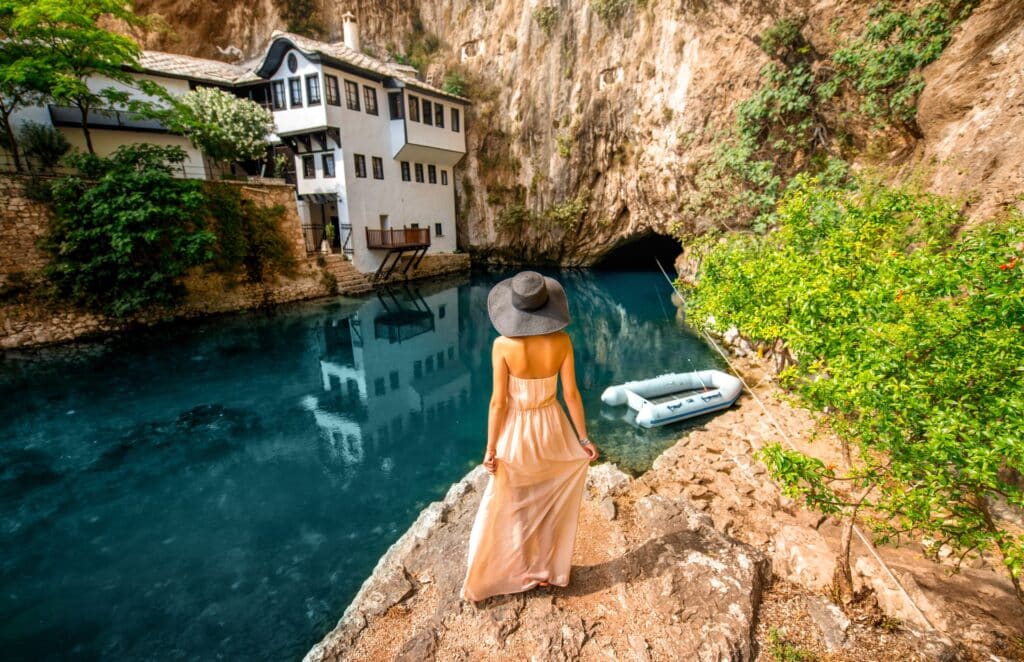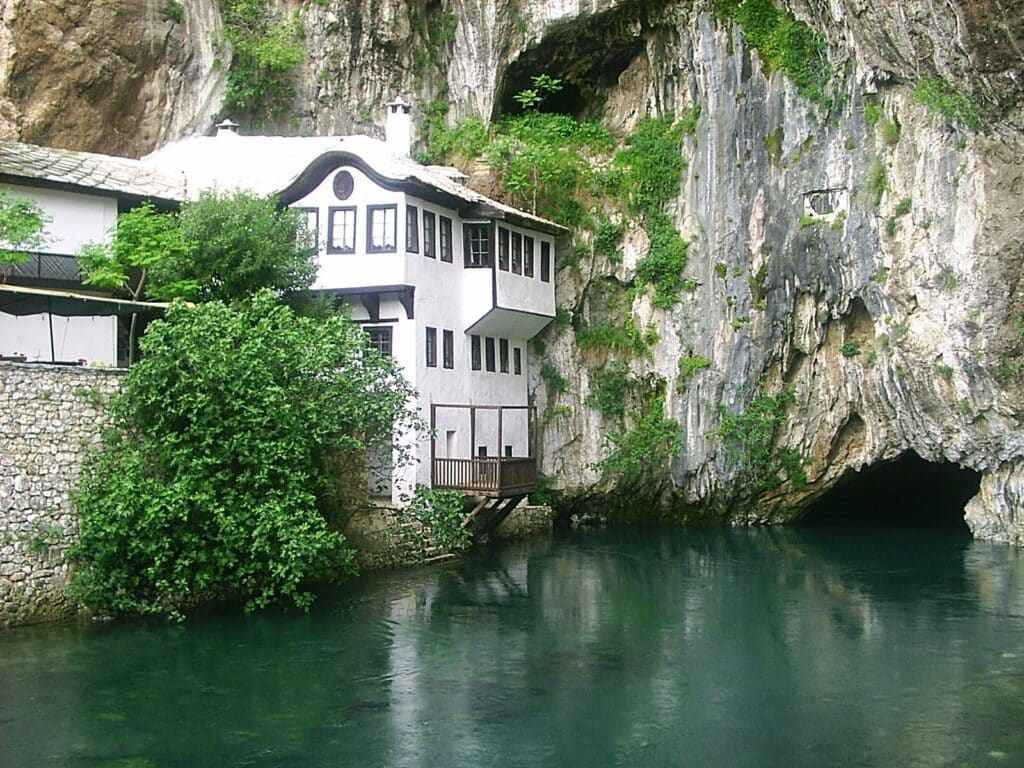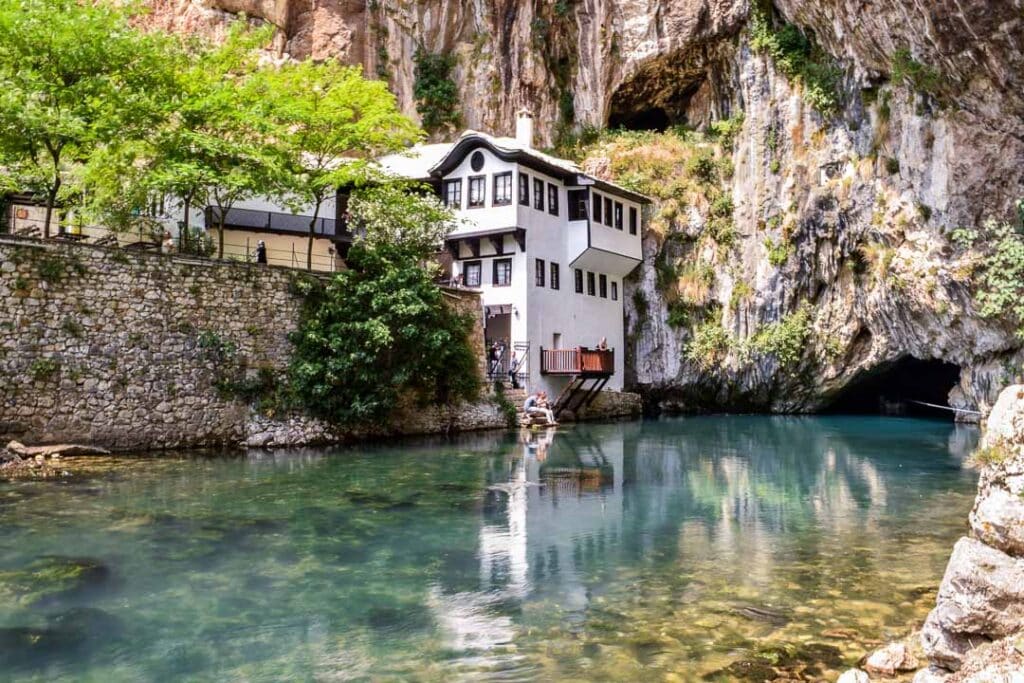Blagaj Tekija, smještena u blizini Mostara u Bosni i Hercegovini, je jedan od najznačajnijih kulturnih i historijskih spomenika u regiji.
Tekija u Blagaju nije samo arhitektonski dragulj, već i mjesto duboke duhovnosti i povijesti. Njezina jedinstvena lokacija, arhitektura, i historijska važnost čine je fascinantnom za istraživanje.
Geografski položaj i prirodno okruženje
Tekija se nalazi na izvoru rijeke Bune, jednog od najsnažnijih izvora u Europi. Prirodni okoliš koji okružuje Tekiju je izvanredno lijep.
Rijeka Buna izvire iz velike pećine, a voda je kristalno čista i hladna tijekom cijele godine. Ovo mjesto nije samo vizualno zadivljujuće, već ima i duboku simboliku u sufijskom vjerovanju, gdje voda predstavlja čistoću i život.

Povijest Blagaj Tekije
Blagaj Tekija datira iz 16. stoljeća, za vrijeme osmanske vladavine u Bosni i Hercegovini. Izgrađena je kao duhovno utočište za derviše, pripadnike sufijskog reda islama. Sufizam, mistična grana Islama, fokusira se na unutarnju čistoću i duhovno putovanje prema Bogu, a Tekija je bila centar za takvu praksu.
Arhitektura Tekije
Arhitektura Blagaj Tekije odražava osmansku graditeljsku tradiciju, s utjecajima lokalnog balkanskog stila. Zgrada Tekije je jednostavna, ali elegantna, s karakterističnim kamenim zidovima i drvenim elementima. Unutrašnjost je skromno uređena, s naglaskom na duhovnost i meditaciju. Posebnost je i njena integracija s prirodnim okruženjem, gdje se čini da je zgrada dio same pećine i rijeke.
Duhovni značaj
Blagaj Tekija je bila i ostala mjesto duhovnog odmora i meditacije. Derviši su prakticirali razne oblike duhovnih vježbi, uključujući molitvu, pjevanje (dhikr), i meditaciju. I danas, Tekija privlači posjetitelje svih vjeroispovijesti, pružajući mirno utočište i prostor za introspekciju.

Blagaj Tekija i turizam
U posljednjih nekoliko desetljeća, Blagaj Tekija je postala popularna turistička destinacija. Posjetitelji iz cijelog svijeta dolaze vidjeti ovu jedinstvenu historijsku i duhovnu znamenitost. Osim što pruža uvid u sufijsku tradiciju, Tekija nudi posjetiteljima priliku da dožive spoj prirodne ljepote i povijesti.
Očuvanje i restauracija
Očuvanje Blagaj Tekije je ključno, s obzirom na njezinu povijesnu i duhovnu važnost. Tijekom godina, Tekija je podvrgnuta raznim restauracijskim radovima kako bi se očuvala njezina struktura i estetika.
Te aktivnosti su ključne za očuvanje ovog spomenika za buduće generacije.
Značaj za bosanskohercegovačku kulturu
Blagaj Tekija nije samo važna za muslimansku zajednicu, već je i važan dio šireg kulturnog identiteta Bosne i Hercegovine. Ona predstavlja suživot različitih kultura i vjera, što je jedna od temeljnih vrijednosti bosanskohercegovačkog društva.

Događaji i festivali
U Blagaj Tekiji redovito se održavaju različiti kulturni i duhovni događaji, uključujući seminare, radionice i festival sufijske glazbe. Ovi događaji pružaju dublji uvid u sufijsku tradiciju i omogućuju posjetiteljima da iskuse bogatstvo ove duhovne prakse.
Utjecaj Blagaj Tekije na lokalnu zajednicu
Blagaj Tekija ne samo da ima duhovno i turističko značenje, već igra i ključnu ulogu u životu lokalne zajednice. Kao centar kulturnih i vjerskih aktivnosti, Tekija doprinosi očuvanju lokalnih tradicija i običaja. Također, privlačenjem turista, doprinosi gospodarskom razvoju regije, potičući zapošljavanje i rast malih poduzeća koja se bave ugostiteljstvom, suvenirima i turističkim uslugama.
Edukativna uloga
Blagaj Tekija služi kao važno mjesto za edukaciju o sufijskim tradicijama i povijesti Osmanskog carstva u regiji. Škole i sveučilišta često organiziraju izlete u Tekiju kako bi studenti mogli iz prve ruke naučiti o ovom značajnom dijelu svoje kulturne baštine. Osim toga, Tekija služi kao mjesto za međunarodne kulturne razmjene, promičući razumijevanje i poštovanje među različitim kulturama i vjerama.
Duhovni turizam
U kontekstu rastućeg interesa za duhovni turizam, Blagaj Tekija privlači posjetitelje zainteresirane za duhovni odmor i samoistraživanje. Osim posjeta samoj Tekiji, posjetitelji često sudjeluju u vodičkim turama koje obuhvaćaju meditaciju i upoznavanje s sufijskim običajima. Ovaj aspekt turizma nije samo ekonomski koristan, već pomaže u širenju svijesti o sufijskim učenjima i praksama.
Očuvanje okoliša
Zbog svoje blizine izvoru rijeke Bune, očuvanje prirodnog okoliša oko Blagaj Tekije je od velike važnosti. Postoje inicijative za zaštitu ovog područja od zagađenja i očuvanje njegove prirodne ljepote. Ove mjere su ključne ne samo za očuvanje Tekije i njezinog okruženja, već i za održivi razvoj turizma u regiji.
Arhitektonska analiza
Arhitektura Tekije predstavlja spoj osmanske i mediteranske arhitekture, što se vidi u upotrebi kamena i drva, kao i u dizajnu koji se harmonično spaja s prirodnim okruženjem. Struktura Tekije je prilagođena stijeni u koju je uklesana, pokazujući izuzetnu vještinu i kreativnost njenih graditelja. Takav dizajn odražava sufijski princip skladnosti s prirodom i okolinom.
Religijska tolerancija
Blagaj Tekija stoji kao simbol suživota i međureligijskog poštovanja, što je posebno važno u kontekstu povijesnih i recentnih sukoba na Balkanu. Mjesto je gdje se mogu susresti i muslimani i nemuslimani, promovirajući dijalog i razumijevanje. Njezina uloga u promicanju mira i tolerancije ne može se precijeniti.
Umjetnost i kultura
Blagaj Tekija je također centar za sufijsku umjetnost i kulturu. Kaligrafija, poezija i glazba su neodvojivi dio sufijske tradicije koja se očituje u Tekiji. Događaji poput koncerata sufijske glazbe i izložbi kaligrafije privlače umjetnike i ljubitelje umjetnosti iz cijelog svijeta, dodatno obogaćujući kulturni pejzaž Bosne i Hercegovine.
Značaj za suvremeno društvo
U današnjem brzom i često materijalističkom svijetu, Blagaj Tekija nudi prostor za usporavanje i refleksiju. Njezina povijest i duhovnost pružaju vrijedan kontekst za razmatranje o važnosti mira, skladnog suživota i unutarnjeg traganja. U tom smislu, Tekija nije samo relikvija prošlosti, već relevantno i živo mjesto koje ima mnogo toga ponuditi suvremenom posjetitelju.
Zaključak
Blagaj Tekija nije samo mjesto izvanredne ljepote i mira, već je i simbol duhovnog traganja i suživota različitih kultura.
Njezin značaj nadilazi granice vremena i prostora, pružajući svjetlo i nadahnuće onima koji je posjete. Kao svjedok historijskih promjena i duhovnog otpora, Blagaj Tekija ostaje dragocjeni dragulj u srcu Bosne i Hercegovine.


